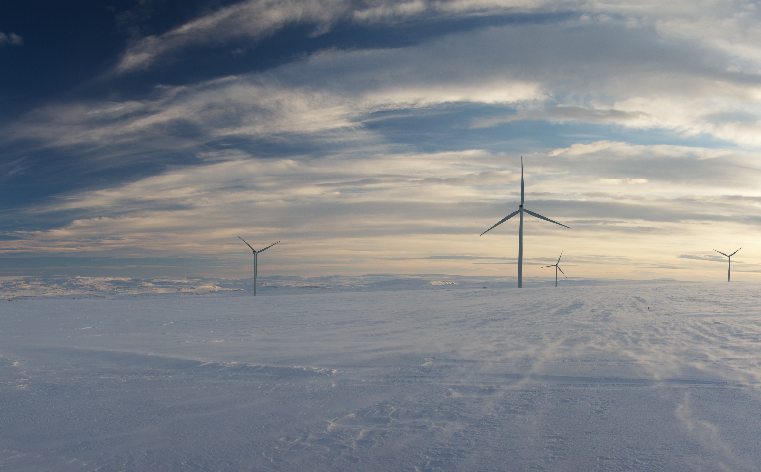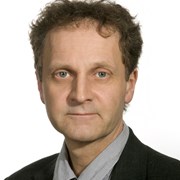Norway’s role as a pioneer in the field of hydrogen technology started more than a century ago at a waterfall. In the steep mountain valley of Rjukan, an engineer and a businessman recognized the potential of the Vemork hydroelectric power station as a way to ensure food production for an ever-growing population. Kristian Birkeland and Sam Eyde wanted to build a factory to manufacture Norwegian fertilizers under the brand name “Norsk Hydro”. An architecturally futuristic hydrogen factory was built next to the power station. After its completion in 1929, it became a tourist attraction between the steep mountains of Rjukan.
Since then, most Norwegian hydrogen research has been conducted in various laboratories at Gløshaugen in Trondheim. In 1951 the Norwegian University of Science and Technology (NTNU), then known as the Norwegian Institute of Technology (NTH), established its own electrochemical engineering institute. This research community has played a key role in what has become a major Norwegian electrochemical industry. Today, behind closed doors at SINTEF, top secret technology is being developed – funded by a number of Norwegian and international industrial companies, including the suppliers of electrolysis technology for hydrogen production. Recently, NTNU and SINTEF won a contract with a manufacturer of fuel cell electric vehicles that run on hydrogen and emit only water vapour.
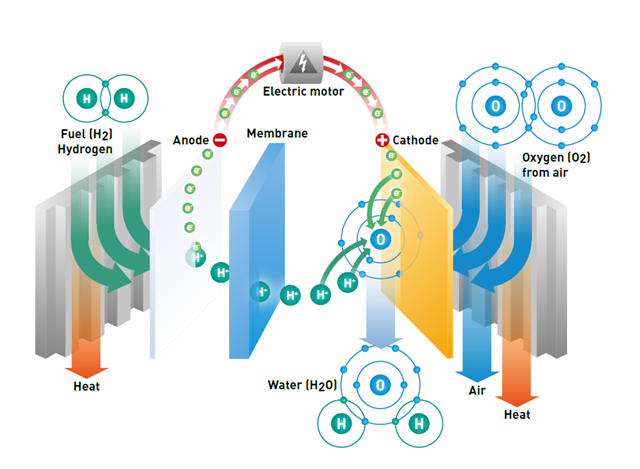
Principle sketch of hydrogen fuel cell. Illustration: SINTEF/Geminiresearchnews
Fuel cell research since the 1980s
NTNU and SINTEF have been working to develop fuel cell technology since the 1980s. In recent years, research and development activities at SINTEF have contributed to some major breakthroughs. Fuel cells have already become competitive in some niche markets, says Steffen Møller-Holst, Vice-President Marketing at SINTEF.
“In Japan, 150,000 fuel cells have been installed households to generate power and heat,” Møller-Holst says. “In the US, more than 10,000 hydrogen-powered forklifts are operating in warehouses and distribution centres.”
He and his research colleagues are now working actively to implement hydrogen technology in Norway with a focus on the transport sector. SINTEF’s project portfolio currently comprises forklifts, heavy-duty trucks and ferries.
“In Germany, the first fuel cell train is already undergoing trials, and Norway is one of many European countries that is now considering hydrogen-powered trains based on the conclusions of a study carried out by SINTEF for the Norwegian Railroad Administration,” says Møller-Holst.
Innovative Asian countries have taken the lead into commercializing fuel cells to power passenger cars. The Korean and Japanese car manufacturers are currently world leaders in a technological transition triggered by the challenges of global warming.
Møller-Holst returned less than two months ago from a three-week stay in Japan, where he held meetings with leading industrial companies that are eager to draw on the knowledge that SINTEF and NTNU have acquired over the last thirty years.
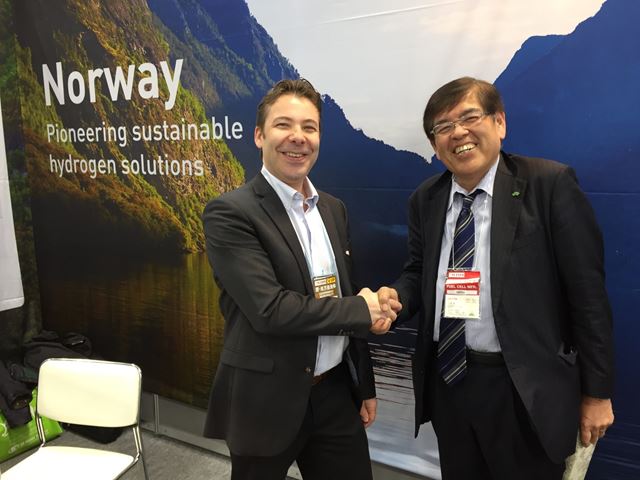
Steffen Møller-Holst, SINTEF, and Dr. Katsuhiko Hirose, Toyota’s Toyota Cars Toyota’s first hybrid car Toyota Prius, which came on the market in 1997. The picture is taken on the Norwegian stand at Fuel Cell ExPo in Tokyo, March 2017. Photo: Norsk Hydrogenforum.
“SINTEF has been involved in 20 hydrogen-related EU-funded projects since 2010, about half of which are still running. This makes SINTEF a significant player in a European context,” says Møller-Holst.
Major investments in hydrogen by the Japanese are good news for SINTEF researchers who are already closely involved with some of the key players in the country.
But why is Japan investing so heavily in hydrogen? The rationale is that more than 90 per cent of the country’s energy demand is currently covered by imported fossil energy sources. Hence, the Japanese are not just interested in hydrogen as a fuel for transport, but also for stationary power generation. In order to reduce greenhouse gas emissions, Japan has already entered into an agreement with Australia to import of hydrogen from 2020.
“SINTEF has been involved both scientifically and politically, promoting Norway as a supplier of hydrogen to Japan based on our extensive energy resources,” says Møller-Holst.
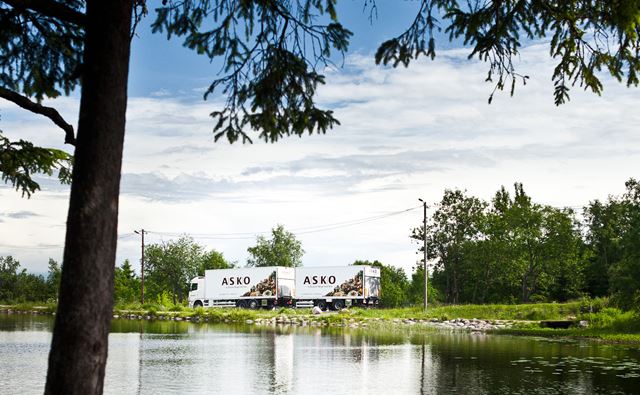
Norway’s largest food wholesaler, ASKO, will have its first hydrogen-powered lorries on its way in 2018. Image lent from ASKO.
In fact, transport is not the only sector in which hydrogen will play a key role. Across the globe, countries deploying an increasing number of wind farms and photovoltaic power plants. However, it is not always possible to use all the wind power that is generated when it is windy, nor from the sun on a sunny day. This surplus electricity has to be stored, which makes producing hydrogen an attractive alternative.
“The German industrial giant Siemens has concluded that hydrogen is the best storage option for energy capacities greater than 10 GWh. More than 30 per cent of the power generation in Germany is covered by wind and solar sources, and pilot testing of hydrogen as a storage medium is well underway, “says Møller-Holst.
Batteries too large, heavy and costly
Møller-Holst is convinced that in order to meet our emissions targets, we have to consider many applications, including goods transport by road, rail and ship. No other technology can compete with hydrogen when it comes to emission-free long-haul transport.
That’s why ASKO, Norway’s largest food wholesaler, is aiming to have its first hydrogen-powered delivery trucks on the roads in 2018. In doing so, it will probably be the first hauler in Europe with a small fleet of heavy-duty hydrogen vehicles. SINTEF has helped initiate and worked closely with the effort. The project manager is Anders Ødegård, who works at SINTEF’s Department of Sustainable Energy Technology.
“The use of batteries to power heavy duty trucks would be very expensive,” says Ødegård. “They would also be so large and heavy that the trucks’ payload capacity would be considerably reduced. We have to obey the laws of physics and respect material-related constraints.”
There is no doubt that electrical drive trains will replace conventional mechanical fossil-based propulsion in the future and that batteries will become very important in all transport segments. However, hydrogen becomes an increasingly good option if vehicles are heavier and have a longer distance to go. This brings us to the railway sector, for which politicians foresee a greater share of freight transport as a means of reducing emissions.
Heading north – with hydrogen
For many years, politicians have suggested that Norway’s longest railway line (Nordlandsbanen) be made emission-free – in the traditional way. In other words, politicians believe that today’s diesel operation should be replaced by electrification, using pylons and overhead lines.
In the spring of 2015, Møller-Holst and his colleagues at SINTEF completed a study for the Norwegian National Rail Administration (JBV) demonstrating that it was possible to operate several of Norway’s railway lines, including Nordlandsbanen, emission-free.
In fact, the report concluded that between 12- 14 million euro can be saved annually on the line from Steinkjer to Bodø (along Nordlandsbanen) if battery- or hydrogen-powered trains were used instead of traditional electrification.
“The report reached a consensus, based on individual experts’ statements obtained during the project, including those from the JBV’s own specialists and SINTEF’s interdisciplinary team,” says Møller-Holst, who led the study.
“Prior to 2020 biodiesel should replace fossil diesel fuel as an interim solution. Then, in the early 2020s, investments in battery-powered trains will be the most attractive option,” he said. “From the mid 2020s, hydrogen is the solution that best fulfils the various requirements that apply for freight trains on the future railroad network.”
Four regions in Germany are currently taking the lead internationally. They have commissioned 100 hydrogen-powered passenger trains. The first is already undergoing trials and the technology is expected to be ready for freight trains before 2025. Møller-Holst argues that Norway should follow the Germans in using hydrogen, and suggests starting with Raumabanen when it comes to passenger trains and Nordlandsbanen for freight trains.
A “wind-wind” situation
Across the fjord from the city of Trondheim there is a mountain chain that the locals call “the Fosen Alps”. This is where Statkraft and TrønderEnergi will construct Europe’s largest wind farm. The wind blows intensively on Fosen all year round, which makes for enormous potential. Annual production from this wind farm alone is expected to reach 3.5 TWh (terawatt hours) of renewable energy, and will be sufficient to supply electricity to Trondheim’s entire population of 170,000.
“Currently, both NTNU and SINTEF are providing decision support to TrønderEnergi as part of the company’s evaluation of the possibility of producing hydrogen from the surplus wind energy,” says Møller-Holst.
Many other stakeholders across Norway are also making the similar assessments looking into hydrogen production. This includes Glomfjord, at a hydroelectric power plant that was a ‘gemini’ plant to that at Rjukan –the cradle of the industrial boom created close to a century ago when Norsk Hydro started producing hydrogen for fertilizers.
SINTEF has recently identified as many as 10 stakeholders that intend to start hydrogen production in Norway. SINTEF is assisting several as they assess possible investments. Interest in hydrogen is really taking off.
However, energy researchers at SINTEF have plans that are even more exciting than hydrogen production from surplus renewable energy. Tommy Mokkelbost is a Senior Research Scientist working at SINTEF’s Svalbard office.
“In Svalbard the impact of climate change is much more severe than in other areas on the planet,” he says. “The ice around the archipelago is melting rapidly, and the glaciers are retreating at record speeds. This creates problems for polar bears in their hunting areas. Moreover, power and heat to Longyearbyen is supplied by Norway’s only coal-fired power station. So what would be more natural than to transform Longyearbyen into the world’s first emission-free community?”
Several options should be studied, of which hydrogen technology represents an exciting alternative, he says.
He envisages that hydrogen could be produced from wind farms located in Norway’s northernmost county, Finnmark, where the wind never stops blowing, but where today’s power grid capacity is very limited. Hydrogen could then be transported to Svalbard in liquid form using hydrogen tankers.
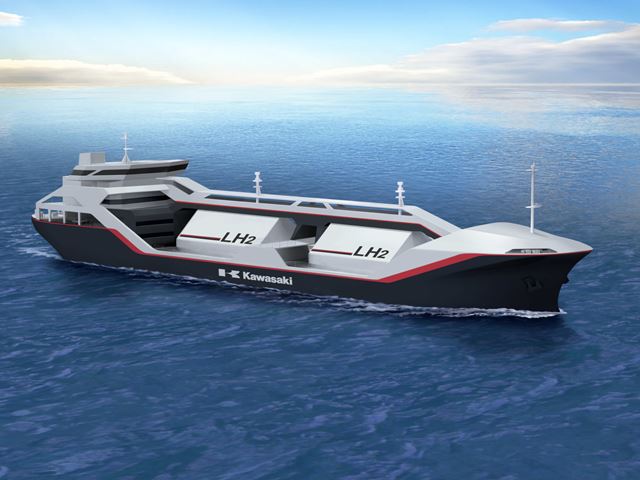
This pilot tanker from Kawasaki will transport 170 tonnes of liquid hydrogen. From 2020 it will be used in hydrogenimport from Australia to Japan. Illustration: Kawasaki.
The Japanese giant Kawasaki Heavy Industries is already constructing a pilot vessel designed to transport liquid hydrogen. The first vessel will be used to import hydrogen from Australia to Japan from 2020.
Møller-Holst supports this idea.
“The passenger cruisers that currently circumnavigate Svalbard, as well as the numerous ferries operating along the Norwegian coast – in and out of our World Heritage fjords burning heavy oils and emitting large quantities of CO2, particulates and NOx – could also be hydrogen-powered, and thus emission-free, in the foreseeable future,” he says.
Making maritime transport “green”
Norway has become a world leader in reducing maritime emissions over the last three decades. The country has succeeded by developing the world’s most advanced and efficient ship designs, paving the road for the use of natural gas as a fuel and, since 2015, operating the world’s first battery-powered car ferry . Next is hydrogen, which will eliminate greenhouse gas emissions also for longer ferry crossings.
Recently, on contract for the shipyard Fiskerstrand, SINTEF was selected to design the world’s first hydrogen ferry in collaboration with regulatory bodies and a number of technology suppliers, including some from Norway. The goal is to have the vessel in the water by 2020. Considerable public funding has been allocated to stimulating development in this field. In addition to SINTEF’s advocacy, the Norwegian Public Roads Administration (Statens vegvesen), which is responsible for all ferries as an integral part of the national road infrastructure, has lately become a key driver in reducing emissions from maritime transport.
The project has already received international attention, not least in Brussels. Public support has been granted from the new Pilot-E funding programme, which is a joint funding instrument involving the Research Council of Norway, ENOVA and Innovation Norway.
“If we in Norway want to secure future revenues from tourism and exotic Arctic adventures, we cannot continue to power Svalbard by coal nor ships with heavy fuel oil,” says Møller-Holst. “We already have the technology and the knowledge we need to reach zero emissions.”
There is no doubt that the “green transition” is well underway: Møller-Holst is already meeting with the Norwegian state-owned oil company Statoil, which is eager to talk to him about its new department, New Energy Solutions.
|
About Steffen Møller-Holst: Møller-Holst is vice president marketing with responsibility for SINTEF’s portfolio of hydrogen-related projects, which are now worth NOK 60 million per year. He holds a Ph.D. in fuel cell technology from NTNU in 1996, and worked for two years with fuel cell system development as part of the US Department of Energy’s hydrogen programme at Los Alamos National Laboratory, New Mexico. During the last 15 years he has been actively pursuing the implementation of innovative technologies, and has devoted substantial time as a policy lobbyist in the fields of low and zero-emission transport. From 2006-2014 he chaired the Norwegian Hydrogen Council as an advisory body to the Norwegian Ministries of Petroleum and Energy, and Transport and Communications. Since 2008 he has been responsible for the transport pillar of EU’s RTD-programme “Fuel Cells and Hydrogen Joint Undertaking” (FCHJU). The FCHJU has a budget of € 1,33 billion granted by the European Commission for the period 2014-2020, as well as an equivalent amount of funds provided by the industrial sector. Since 2015 Møller-Holst has been Board Chair of the Norwegian Hydrogen Forum, which is a trade organisation for industrial and academic stakeholders as well as NGOs engaged in the field of hydrogen technology. |
